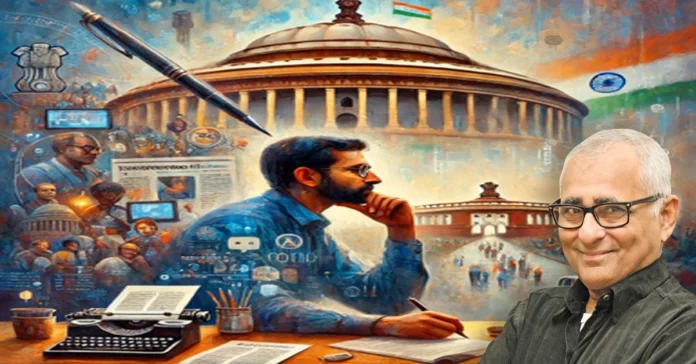By Inderjit Badhwar
In a democracy as diverse and complex as India’s, numbers are not just statistics—they are instruments of power, equity, and sometimes, exclusion. This week’s cover story, by senior journalist Vikram Kilpady, delves deep into one of the most consequential developments facing the Indian Republic in the coming years: the long-delayed, but now officially scheduled 2027 Census.
At first glance, a national census may seem like a routine bureaucratic exercise, an update to our demographic record books. But as Kilpady incisively argues, this is no ordinary count. For one, it comes 16 years after the last Census, an unusually long gap that has left governments and policymakers working with outdated figures and questionable projections. More critically, this upcoming enumeration carries within it the seeds of potentially seismic changes —political, constitutional, and social.
The story’s real significance lies in its intersection with two explosive national debates: delimitation and caste enumeration. Both are deeply sensitive, and both are being quietly, yet inexorably, set into motion.
The constitutional mandate is clear: the first Census conducted after 2026 will trigger the process of delimitation—redrawing parliamentary and assembly constituencies based on updated population data. But the implications of that redrawing are anything, but straightforward. States in the South, which have historically embraced family planning and witnessed slower population growth, fear being penalised with a loss of seats. Conversely, states in the Hindi heartland—with higher population growth and relatively slower socio-economic development—stand to gain representation in Parliament. This, critics argue, rewards irresponsibility and punishes progress.
This looming faultline is already beginning to fracture old political alignments. Tamil Nadu Chief Minister MK Stalin has raised the alarm, accusing the centre of attempting to dilute southern representation under the guise of constitutional compliance. His Andhra Pradesh counterpart, Chandrababu Naidu, more cautious and politically aligned with the ruling BJP, has nonetheless acknowledged the stakes and suggested a compromise—freeze the current number of seats per state, if expanding the Lok Sabha strength from 543 to 800-odd, allot more seats in proportion to each state.
That such discussions are gaining ground even before a single household has been surveyed should give us pause. The Census is being positioned not merely as an administrative necessity but as a tool of realignment—of India’s electoral map, its power structure, and perhaps its foundational promises.
Overlaying this is the government’s decision to include caste enumeration in the upcoming Census—the first such effort since 1931. Post-Independence India made a conscious choice to sideline caste in official data, projecting instead a modernist vision of unity and equality. But reality has long diverged from idealism. Caste remains embedded in every aspect of Indian life, from educational access and job reservations to electoral strategies and social mobility.
The inclusion of caste in the 2027 Census is, in part, a response to growing demands from the Opposition and regional parties, particularly the Congress, to acknowledge the caste realities of Indian society. But it also opens up new possibilities—and new tensions. What happens if the data reveals that certain dominant castes are no longer as disadvantaged as previously believed? Will quotas be restructured? Will the judiciary revisit the 50 percent reservation cap? Will sub-categorisation within SC/ST groups alter the hierarchy of benefits?
The answers to these questions are not yet known. But what is certain is this: the 2027 Census is not just a count—it is a confrontation with India’s deepest contradictions.
At India Legal, we believe that the law and the Constitution are living documents—shaped by data, driven by people, and interpreted in context. The Census—especially one as loaded as this—will feed directly into judicial and legislative decisions that could redefine the nature of our republic. Whether it is the Women’s Reservation Bill awaiting its moment post-delimitation, or the Supreme Court’s recent greenlight for the sub-categorisation of SCs and STs, the dominoes are lining up.
This issue’s cover story offers not just an exploration of the Census mechanics, but a sober examination of what the numbers may unleash. It charts how a delayed count has become a ticking political clock, one that could redraw not just boundaries, but the very balance between representation and responsibility, federalism and fairness.
As we put together this edition, it struck us how few policy conversations in India are grounded in up-to-date, empirical data. Much of our welfare planning, resource allocation, and reservation debates are based on outdated or incomplete statistics. In that vacuum, myths flourish, ideologies harden, and communities jostle for a bigger share of an unseen pie.
This Census, if done right, could correct that. But it must also be done fairly, transparently, and with safeguards for the vast quantities of personal data it will collect—digitally, for the first time. In a country where Aadhaar leaks are commonplace and data protection laws remain weak, the risks are real.
That is why this story matters—not just to politicians, planners or constitutional experts, but to every citizen who calls India home.
The act of counting, we often say, is neutral. But in India, it never really is. It is both an assertion and an aspiration—of who we are, and who we want to be.


